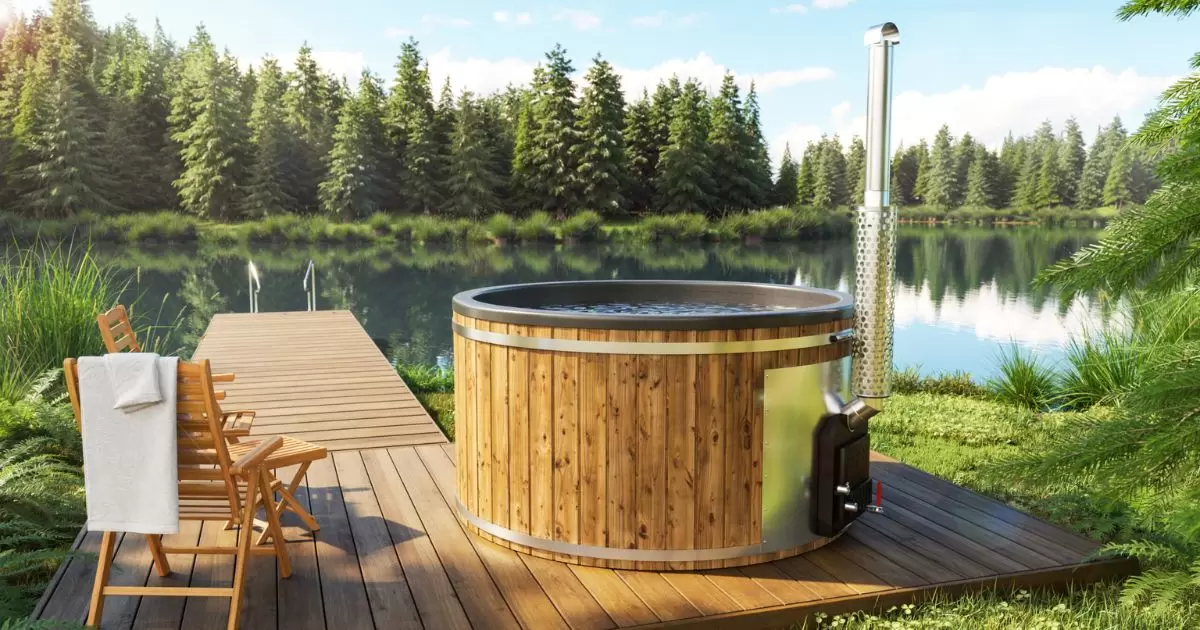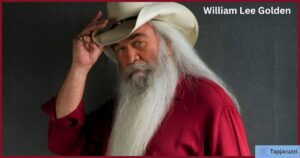Imagine soaking in a warm cedar hot tub, surrounded by nature, as a crackling wood fire heats the water. Sounds divine, doesn’t it? Wood fired hot tubs and wood burning stoves offer a unique, back-to-basics experience that connects you with the elements. These rustic amenities have grown increasingly popular, especially in rural areas and among eco-conscious consumers seeking a low-impact, sustainable alternative to traditional hot tubs.
Picture this: You’re sitting in your wood fired hot tub on a crisp autumn evening, gazing up at the stars. The gentle crackle of the fire mingles with the chirping crickets, creating a soothing soundtrack. The sweet aroma of cedar fills the air as the wood stove slowly heats the water. It’s a simple pleasure, yet profoundly relaxing and grounding. This is the magic of a wood burning hot tub experience.
Imagine sinking into the warm, natural embrace of a cedar wood hot tub. As you settle into the sublimely comfortable contours of the tub, the stresses of the day begin to melt away. You take a deep breath, inhaling the rich, earthy scent of the western red cedar wood. A sense of calm washes over you as you gaze up at the star-studded sky, surrounded by the gentle sounds of nature.
The Science Behind Wood Fired Hot Tubs
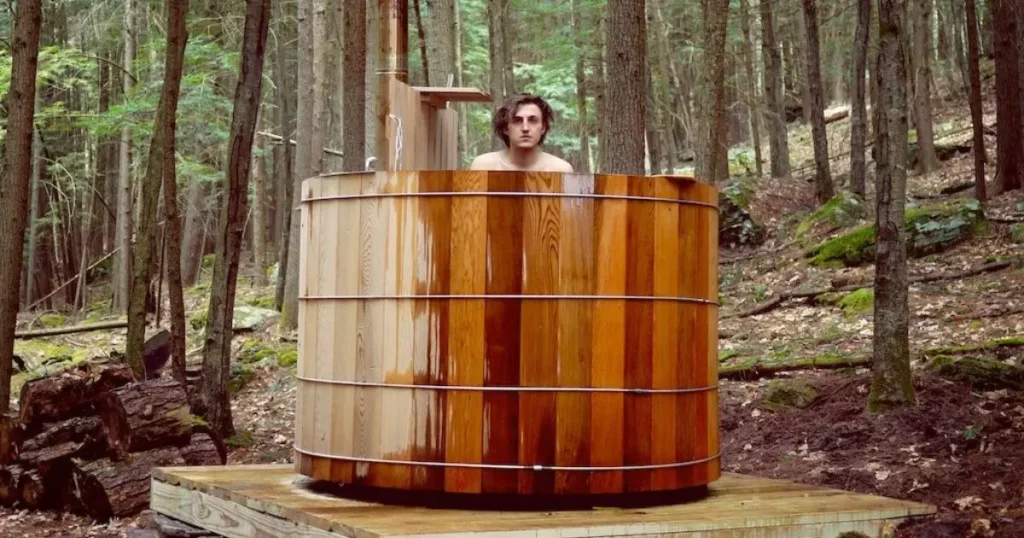
So, how do these wood-heated wonders work? The secret lies in a principle called thermosiphon, which allows for natural water circulation without the need for electricity or pumps. As the wood stove heats the water, it causes the warmest water to rise to the top of the tub. Simultaneously, cooler water is drawn into the stove to be heated, creating a gentle, effortless flow.
Here’s a simple diagram to illustrate the process:
Pretty ingenious, right? This natural circulation system means no noisy pumps or vibrations, just the soothing sounds of nature.
The thermosiphon effect is a remarkable example of physics in action. As the water is heated by the wood stove, its density decreases, causing it to rise upwards. This creates a continuous cycle of warm water rising and cooler water sinking, establishing a gentle yet efficient circulation pattern.
Two Designs for Wood Fired Hot Tubs
When it comes to wood fired hot tubs, there are two main design options: internal heaters and external heaters.
Internal Heater Hot Tubs
With an internal heater design, the wood stove is submerged within the hot tub itself. This takes up a significant amount of interior space, reducing the number of bathers the tub can accommodate.
While internal heater hot tubs offer a certain rustic charm, their design limitations can be a drawback. By placing the wood stove directly inside the tub, you lose valuable soaking space – often as much as one-third of the total internal area. This means that for a group of friends or family to comfortably fit, you’ll need a much larger (and more expensive) hot tub than with an external heater design.
External Heater Hot Tubs
In contrast, external heater hot tubs have the wood stove positioned outside the tub, with pipes running to circulate the heated water. This design offers several key advantages.
Advantages of External Wood Fired Hot Tub Heaters
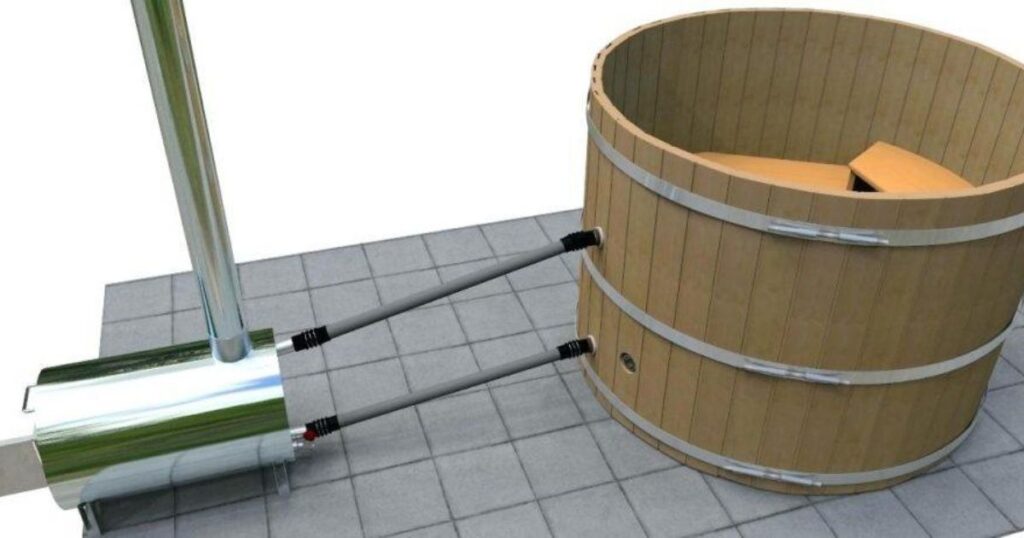
- More Interior Space: By keeping the heater external, the entire tub is available for bathers, maximizing capacity.
- Insulated Cover: You can use a fully insulated cover to retain heat, as there’s no internal heater obstructing it. This allows you to maintain a warm temperature for hours without restarting the fire.
- No Critical Water Level: With an internal heater, you must maintain a precise water level to avoid exposing (and potentially melting) the stove. External heaters eliminate this concern.
- Cleaner Tub: Fueling the fire from outside means no debris falls into the tub water, minimizing the need for frequent cleaning.
- Safer Chimney: The chimney is positioned away from bathers, reducing any risk of contact with a hot surface.
- Easy Cleaning: External heaters are simpler to access and keep free of debris that can accumulate in hard-to-reach internal heater areas.
For these reasons, external heater designs are often considered the superior choice for wood fired hot tubs, offering greater flexibility, convenience, and safety for users.
The external heater design is a game-changer for wood fired hot tubs. It maximizes the interior space for bathers while making it easier to control the temperature and maintain the tub. It’s a more user-friendly and practical option overall. – John Smith, Wood Hot Tub Enthusiast.
Read More : Benefits Of A Hot Tub
Maintaining a Wood Burning Hot Tub
One of the biggest advantages of a wood burning hot tub is its low-maintenance nature. Unlike traditional hot tubs that require a complex regimen of chemical treatments, a wood fired tub needs very little upkeep. Simply fill it with fresh water and enjoy a soak or two, then drain and refill as needed. No chemicals required!
This low-maintenance approach has several benefits. First and foremost, it eliminates the need for harsh chemicals that can be irritating to the skin and eyes, not to mention environmentally unfriendly. With a wood fired hot tub, you can enjoy a pure, chemical-free soaking experience that’s gentle on both your body and the planet.
Another advantage is the simplicity of the process. There’s no complicated startup routine or strict water balancing act to perform. Just fill the tub, light the fire, and relax! When you’re ready to refresh the water, simply drain and refill. It’s a straightforward, hassle-free way to maintain your hot tub.
As for the exterior, you have the option to stain the cedar to maintain its rich, vibrant color. Left untreated, the wood will naturally weather to a beautiful silvery-gray patina over time. Either way, a light sanding and re-staining every few years is all it takes to keep your wood hot tub looking its best.
Optional Filter & Jet System
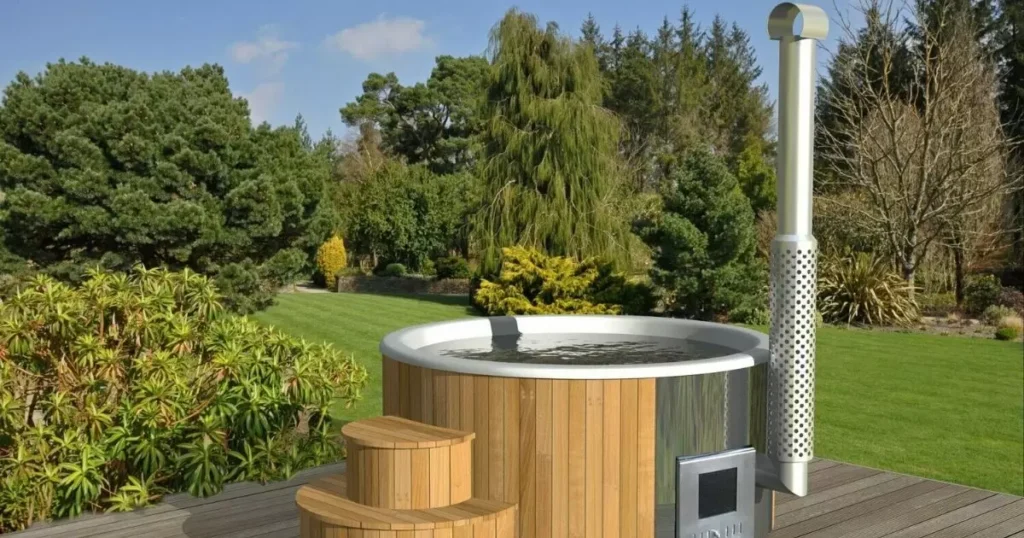
While the simplicity of a wood fired hot tub is part of its charm, some customers appreciate having the option to add a few modern conveniences. That’s why many manufacturers offer an upgraded filtration and jet system.
This optional setup typically includes a 110-120V pump and filter, along with 4-6 hydrotherapy jets for a soothing massage experience. The filter allows you to reuse the same water for weeks or even months without draining, reducing water consumption.
With this upgrade, you can enjoy the best of both worlds – the rustic allure of a wood heated tub combined with the practical benefits of water filtration and hydrotherapy jets.
The addition of a filter system is particularly appealing for those who plan to use their wood fired hot tub more frequently or for extended periods. By filtering the water, you can maintain clarity and cleanliness without the need to drain and refill as often.
And let’s not forget the luxurious indulgence of the hydrotherapy jets. These strategically placed jets create a soothing massage effect, kneading away tension and promoting overall relaxation. It’s a spa-worthy experience that takes your wood fired hot tub to the next level of comfort and rejuvenation.
The optional filter and jet system was a game-changer for me. I love the simplicity of a wood fired tub, but having the ability to filter the water and enjoy a hydromassage was the best of both worlds. It really elevated the entire experience.” – Sarah Wilson, Wood Hot Tub Owner
Managing Temperature & Heating Times
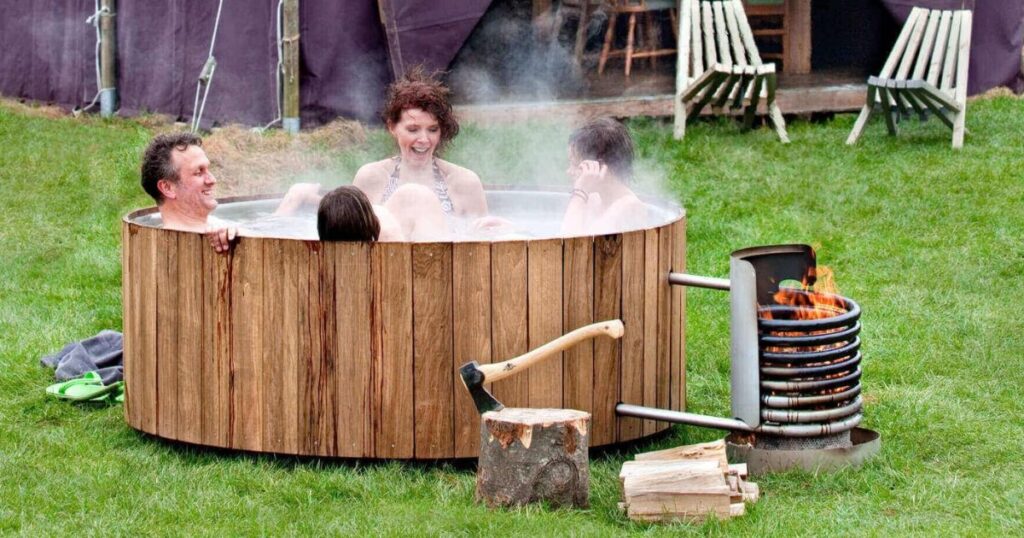
It’s important to note that wood fired hot tubs lack the precise temperature control of a standard electric or gas tub. The heat will tend to stratify, with the warmest water rising to the top and cooler water sinking below.
To combat this, it’s essential to stir the water occasionally with a paddle or similar tool. This will help blend the varying temperatures for a more consistent soak. Monitoring the water with a thermometer can also help you gauge when to add more wood or let the fire die down.
As for heating times, there are several factors at play:
- Water volume: Larger wood fired hot tubs will take longer to heat than smaller soaking tubs.
- Stove BTU output: A higher-output stove (55,000+ BTU) will heat water faster than a lower-output model (30,000-40,000 BTU).
- Wood type: Seasoned hardwoods like oak or maple will burn hotter and longer than softwoods.
- Outdoor temperature: Heating times will be faster on a warm summer day versus a frigid winter night.
With experience, you’ll get a feel for how much wood is needed and the approximate heating times for your specific setup. The lack of precise control is simply part of the authentic wood-fired experience.
Here’s a rough guide to heating times for a 400-gallon wood fired hot tub using a 55,000 BTU Timberline stove and seasoned oak firewood:
- Starting from cold water (40°F): Approximately 4-5 hours to reach a comfortable soaking temperature of 100-104°F.
- Maintaining temperature: Adding 2-3 logs every 30-45 minutes to keep the water consistently warm.
- Reheating after a soak: Roughly 2-3 hours to reheat the water to soaking temperature after it has cooled down.
It’s important to note that these times are estimates and can vary significantly based on factors like outdoor temperature, wind chill, and the specific hot tub and stove you’re using. Always monitor the water closely and adjust the fire as needed to achieve your desired temperature.
The Art of Controlling the Wood Fire
Speaking of the fire, mastering the operation of your wood stove is key to an enjoyable wood hot tub soak. Here are some quick tips for safe and effective fire control:
- Use Seasoned Hardwood: Start with dry, seasoned hardwood for optimal heat and minimal smoke. Avoid green wood or softwoods that burn less efficiently.
- Proper Fire Starting: Use a top-down or upside-down fire lighting method for a cleaner, hotter burn. This involves placing the largest logs on the bottom and the kindling on top, allowing the fire to burn from the top down.
- Maintain the Fire: Add small amounts of wood as needed to maintain the fire. Avoid overloading the stove, as this can lead to excessive smoke and poor combustion.
- Control Airflow: Use the air intake and damper controls to regulate oxygen flow and heat intensity. Open the air intake to increase oxygen flow and keep the fire burning brightly. Adjust the damper to control heat and smoke levels in the chimney.
- Extinguish Safely: When finished, allow the fire to burn out completely before shutting the air intake. Never extinguish the fire with water, as this can damage the stove.
- Proper Chimney Maintenance: Regularly inspect and clean the chimney to prevent creosote buildup, which can be a fire hazard.
Choosing Your Wood Fired Hot Tub & Stove
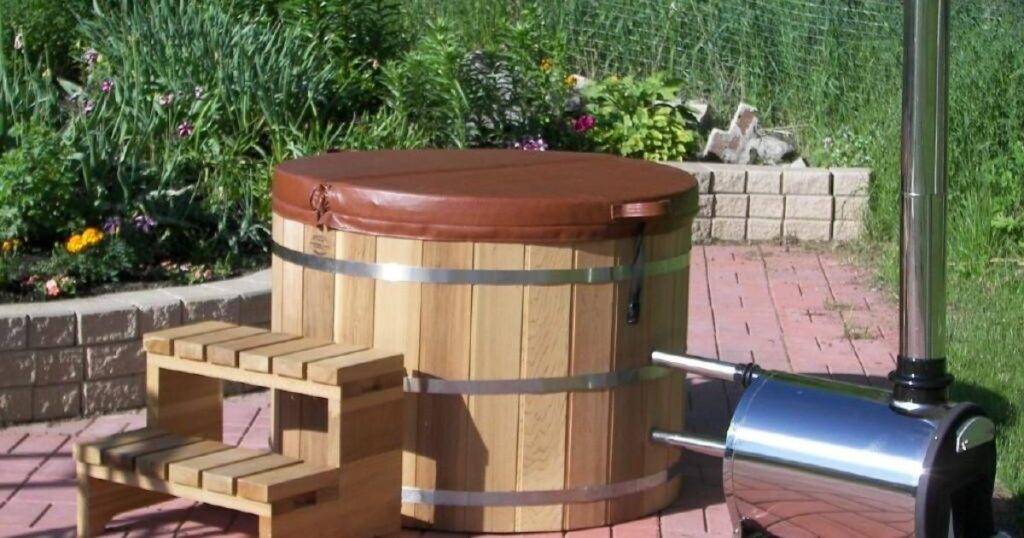
When it comes time to select your wood hot tub and stove, there are two manufacturers that stand out as industry leaders: Northern Lights and Timberline.
Northern Lights Cedar Tubs offers a wide range of wood fired hot tubs and soaking tubs, from compact 2-person Japanese ofuros to spacious 8-person oval tubs. Their matching Timberline wood stoves are available in three BTU outputs to suit any tub size. Notable features include 100% clear western red cedar construction, external heater designs, and elegant skirting options.
The Northern Lights Ofuro is a perfect example of their craftsmanship. This petite yet luxurious tub is handcrafted from clear cedar and designed for two bathers. Its compact size makes it ideal for smaller outdoor spaces, while the external heater design maximizes interior soaking room. Pair it with the Timberline “Campfire” 30,000 BTU stove for a cozy, effortless wood-fired soak.
Timberline Wood Stoves are known for their durable, efficient construction and clean-burning technology. Their stoves pair perfectly with both Timberline and Northern Lights hot tubs, offering 30,000 to 55,000+ BTU outputs.
The Timberline “Blaze” 55,000 BTU stove is a popular choice for larger wood fired tubs. Its robust steel construction and precise airflow controls allow for an intense yet efficient burn, heating even the largest tubs in a reasonable timeframe. The clean-burning design minimizes smoke and creosote buildup for safer, hassle-free operation.
Conclusion
There’s something undeniably special about soaking in a cedar hot tub heated by a crackling wood fire. It’s an experience that connects you with nature in a profound, grounding way. Close your eyes and imagine yourself relaxing on the fireside in this warm, rustic sanctuary.
The soothing heat, the sweet cedar aroma, the gentle sounds of the forest – it’s a simple pleasure, yet profoundly restorative for mind, body, and spirit. If this enticing vision resonates with you, we encourage you to explore the world of wood fired hot tubs and wood burning stoves further.
Reach out to the skilled teams at Northern Lights and Timberline to learn more about crafting your own eco-friendly spa experience. Take the first step towards your own personal oasis of relaxation. Immerse yourself in the timeless joys of a wood-heated soak, and reap the mental, physical, and spiritual benefits of this unique, back-to-nature indulgence.
